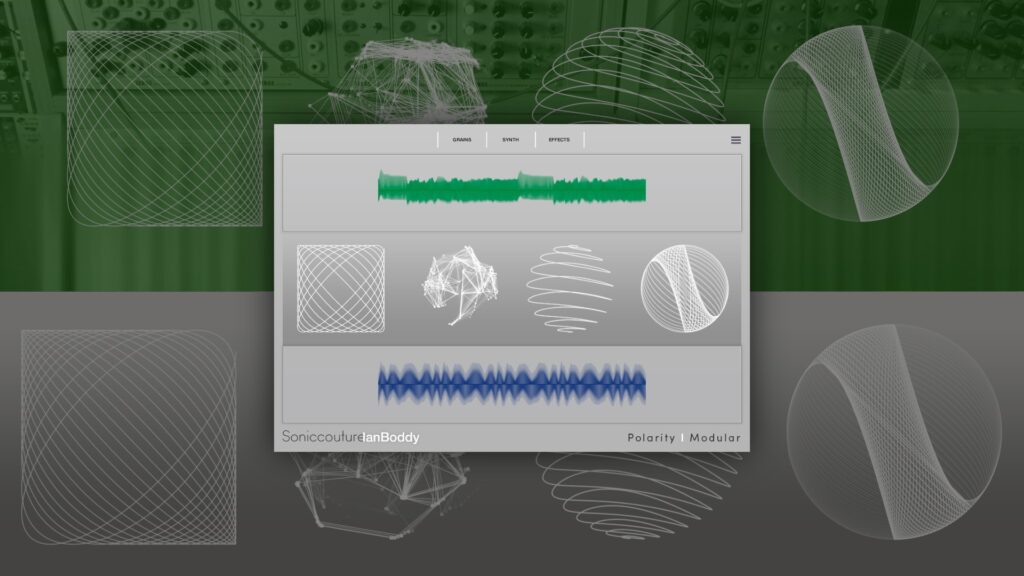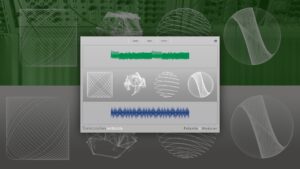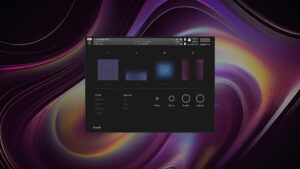Soniccouture’s Polarity Modular is the second entry in their Polarity line — a series built around a custom dual-layer granular engine powered by curated sound design from different artists. After being hugely impressed with Polarity Tension, my expectations were sky-high for this follow-up. Thankfully, Modular not only delivers — it expands the idea into new, strange, deeply creative places.
From the very first preset, Polarity Modular feels like stepping into another dimension. It’s a machine for sonic exploration, textures, and timbral accidents that feel genuinely fresh. While many granular engines lean cold, metallic, or harsh, Polarity Modular manages to be smooth, glossy, glassy, cloudy, alien, organic, and synthetic all at once — often in the very same sound.
“Polarity Modular sounds absolutely f*ing lush.” — Ian Boddy**
(And yes, he’s right.)
Interface & Workflow — A Playground, Not a Science Experiment
Coming from Polarity Tension, the interface of Polarity Modular feels immediately familiar. It uses the same overall layout — the three main pages for Grains, Synth, and Effects, with the clean macro-driven Main page at the center of the experience. If you’ve spent time with Tension, you’ll slip right into Modular without thinking.
The interface itself also has a distinct visual character. It’s a fascinating blend of influences: part hand-drawn squiggles, part painterly color fields, part 90s retro hardware aesthetic with pale grays and glowing accents. It somehow manages to look both old and futuristic, like a piece of old laboratory equipment redesigned by a modern concept artist. The waveforms are beautifully displayed, the grain-scanning animations are clear and informative, and the macro controls are not only visually engaging but genuinely revealing in how they unfold the sound.
“It’s like a sonic exploration machine — you twist a knob and have no idea what’s going to happen, in the best way.”
What I loved most is that the macro behaviours are deeply designed, not random. Small movements often reveal entire new sub-textures, harmonics, resonances, or tonalities. Many granular engines give you chaos; Polarity Modular gives you directional chaos, which is much more inspiring.
The Sound — Alien, Otherworldly, and Weirdly Beautiful
Sound designer Ian Boddy supplied an enormous collection of modular and analog source material — everything from Moog and Roland systems to Buchla Easel recordings — along with impulse responses captured from his own gear, including Space Echo units and spring reverbs (which are exclusive to this instrument). These IRs live in the effects section and add an unmistakable character. Just as impressive is the curation itself: the pairings within each preset are bold, unexpected, and creatively charged.
This was one of the standout qualities of Modular: instead of layering two nearly identical waveforms (a common trap in sound design), Soniccouture consistently pairs high-contrast sources. You might get a gritty resonant metal sweep layered with a warm analog smear — or a droning low ripple paired with sparkly noise artifacts. This contrast fuels creativity.
“It doesn’t sound like anything else — it feels like a parallel dimension.”
“Beautiful textures, landscapes, resonances — endlessly explorable.”
Across every preset category, Polarity Modular delivers without ever faltering. However it’s worth noting: the preset folders are only loose suggestions. Pads may hide drones, atmospheres may hide soundscapes, and soundscapes may hide delicate tonal textures. There’s a lot of overlap between the categories, so don’t let a folder name limit your exploration — some of the most interesting discoveries come from wandering into sections you might not normally click.
Genre Fit & Use Cases
When it comes to the kind of music you’ll end up writing with Polarity Modular, the answer is wonderfully subjective. This instrument behaves like a mirror — it reflects your own instincts back at you. That’s partly due to the wide stylistic palette of source material, but it’s also because the engine itself encourages personal exploration. Its design doesn’t push you toward a single sound or genre; instead, it invites you to follow whatever resonates with you and let the instrument amplify it.
In my hands, it immediately pushed me toward the styles I love most: dark ambient, textural drone work, moody cinematic scoring, and those brighter, almost low-fi ambient soundscapes that sit somewhere between dreamlike and nostalgic. For me the engine seems to invite that kind of slow-moving, atmospheric writing — long tones, evolving textures, harmonically ambiguous beds, and subtle shifts that reward patience.
“Hello, dark ambient heaven.”
“You can just get lost in these textures.”However, it’s important to remember that the included source samples are only the beginning — you can also load your own.
A Compositional Tool, Not Just a Texture Generator
One of the most surprising aspects of Polarity Modular is how naturally it becomes a compositional tool in the realm of pitch and tonality, rather than just a generator of texture. The macro controls — especially the first/A macro governing granular behaviour — don’t simply shift texture or density. They introduce pitch movements within the granular engine that can create melodic contours, miniature motifs, and, with the right settings, even emergent chord progressions.
Plenty of textural instruments allow you to shape grains in broad strokes, but Polarity Modular goes further by giving those grain shifts a musical direction. You’re not just sculpting texture — you’re discovering lines, harmonies, and shapes you didn’t necessarily plan, making the engine feel like an active collaborator in the writing process.
“The pitch element is a compositional tool — you can scroll through and get new harmonies and inspirational starting points.”
Loading Your Own Samples — A Massive Creative Multiplier
Perhaps to many the most important feature:
You can drag your own samples into both layers.
And since the presets already demonstrate effective macro mappings, you can:
- Find a preset with great movement and tonal behavior
- Save it
- Load your own source material into it
- Instantly get something deeply personal and unique
This transforms Polarity Modular from “a great instrument” into a full-scale sound design system.
“Being able to drop in your own sounds multiplies the usability exponentially.”
The Sound in Words — As Best As Words Can Attempt
Throughout the demo, I kept trying to put the character of Polarity Modular into words, and the best I could arrive at was a blend of contradictions: glassy yet cloudy, glossy yet resonant, alien yet organic-meets-synthetic. The sounds can be soft but sharp, smooth but textured — always shifting, always a little mysterious. There’s an otherworldly quality to it, as if the instrument operates from a parallel dimension where analog circuitry and granular physics coexist in an unnatural but strangely beautiful harmony.
It’s this hybrid, shimmering character that makes Polarity Modular such a natural fit for ambient and dark ambient work, deep drones, cinematic scoring, abstract electronic sound design, modular-inspired textures, and experimental composition of all kinds. Few tools feel this inspiring — or this capable of pulling you into worlds you didn’t expect.
Conclusion — A Must-Have for Sound Designers & Ambient Composers
Polarity Modular is one of those rare instruments that feels like a creative partner instead of just another tool.
It’s bold.
It’s textured.
It’s deep.
It’s wildly exploratory.
It sounds unlike anything else on the market.
And when paired with Polarity Tension, the two form a complementary pair: Tension being more overall dark and stylistically focused, Modular being more expansively dimensional.
“It’s a creative playground — a deep well of sound discovery.”
“This isn’t just an instrument. It’s a reflection of you.”
If you work in sound design for film or games, ambient music, dark drones, experimental scoring, sci-fi textures, granular electronica, or anything that thrives on movement, depth, and atmosphere, Polarity Modular is an exceptionally powerful tool. And the moment you start loading in your own samples, it becomes even more genre-agnostic, ready to follow your creative direction wherever it leads.
If you’re a sound designer, ambient composer, experimental producer, cinematic scorer, or modular enthusiast… this is a no-brainer.
Get Polarity | Modular here: https://www.soniccouture.com/en/products/28-experimental/g93-polarity–modular/
Full review: https://youtu.be/L4jxbhrzdK4
No talking edit: https://youtu.be/gGrreWquX0w





